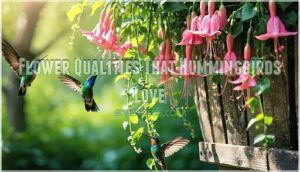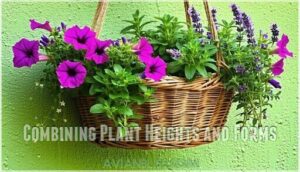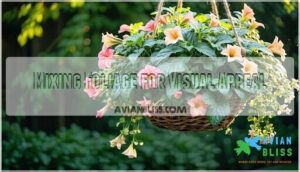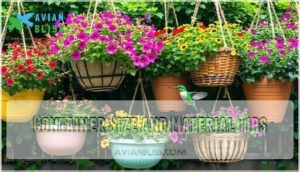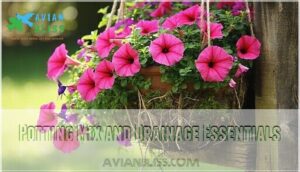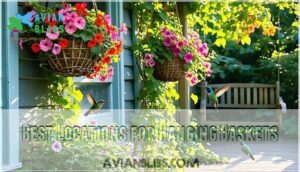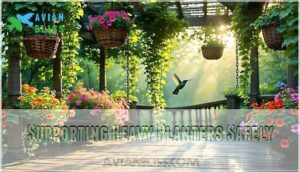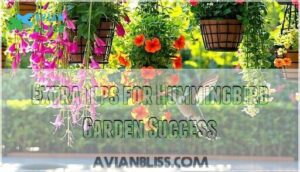This site is supported by our readers. We may earn a commission, at no cost to you, if you purchase through links.
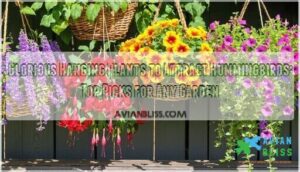
Fuchsias, Cuphea, Petunias, and Lantana step right into the spotlight, flaunting nectar-rich, tubular blooms in bold reds and purples.
Mix in the trailing grace of Lobelia or shade-lovers like Impatiens and Begonia for color that whispers "stop by."
Hummingbirds love a patchwork of heights and textures, so cluster mounding, trailing, and upright forms together.
Give each basket space in morning sun, keep soil moist, and your garden’s bound to become a hummingbird’s favorite haunt.
As for what else can spark their fancy—stay tuned.
Table Of Contents
- Key Takeaways
- Best Hanging Plants to Attract Hummingbirds
- Flower Qualities That Hummingbirds Love
- How to Design Hummingbird-Friendly Hanging Baskets
- Choosing The Right Container and Placement
- Extra Tips for Hummingbird Garden Success
- Frequently Asked Questions (FAQs)
- How often should I water hanging plants for hummingbirds?
- Can I use artificial flowers in hanging baskets?
- What time of day do hummingbirds visit hanging plants?
- Are there specific fertilizers best for hummingbird-attracting plants?
- How do I protect hanging plants from pests?
- Will hummingbird feeders deter visits to hanging baskets?
- Are hummingbird-attracting plants safe for pets?
- How do pests affect these floral displays?
- Which diseases commonly affect hummingbird-friendly plants?
- Can hanging baskets attract other pollinators, like butterflies?
- Conclusion
Key Takeaways
- Choose nectar-rich, tubular blooms – You’ll attract more hummingbirds with plants like fuchsia, cuphea, petunias, and lantana that offer bold reds and purples with easy-access flower shapes.
- Mix plant heights and textures – You should combine mounding, trailing, and upright forms in your baskets to create a patchwork of heights that hummingbirds love.
- Focus on proper placement and care – You’ll get better results by positioning baskets in morning sun, keeping soil consistently moist, and ensuring good drainage.
- Plan for continuous blooms – You can keep hummingbirds visiting all season by selecting plants with staggered bloom times and deadheading spent flowers regularly.
Best Hanging Plants to Attract Hummingbirds
If you want to see hummingbirds darting around your garden, start by picking the best hanging plants for them.
These options offer lots of nectar, showy flowers, and the perfect home for these tiny visitors.
Fuchsia – a Hummingbird Favorite
Brighten your hummingbird garden with Fuchsia varieties—one of the best hummingbird plants for hanging baskets.
Fuchsia blossoms sparkle like living jewels, drawing hummingbirds to your hanging baskets and brightening every shady corner
These bloomers thrive in afternoon shade, dangling blossoms like living jewels.
Mind their shade needs, give them regular pruning, and don’t forget winter care.
Pair with shade-loving companion plants and watch as Fuchsias turn your outdoor space into a favorite stop for attracting hummingbirds.
Trailing Lobelia – Delicate & Colorful
Almost any hanging plant collection benefits from the airy touch of trailing Lobelia.
You’ll love the variety it brings to your hummingbird garden.
- Explore the vivid Lobelia Colors—blue, white, and purple.
- Prioritize Lobelia Care by keeping soil moist.
- Try creative Lobelia Combinations in baskets.
- Check Lobelia Placement in light shade for best results with your nectar plants.
Cuphea, Petunia, and Lantana Varieties
Looking for a burst of action in your hanging plants?
Cuphea colors catch the eye with their punchy reds, while petunia shapes spill from baskets, offering bold bloom size and constant nectar.
Lantana hardiness means flowers keep coming, even under the midsummer sun.
Blend these variety combinations for attracting hummingbirds—far more lively than topping off those hummingbird feeders, with constant nectar.
Impatiens, Begonias, and Shade-Lovers
If your space is more shady retreat than sun-drenched meadow, you’re in luck. Shade Begonias and Impatiens Varieties are hummingbird favorites, adding colorful shade and charm to hanging plants.
Hanging Impatiens bloom in reds and pinks—perfect for attracting hummingbirds. Just remember—Begonia care means moist soil and dappled light for the best blooms.
- Hanging Impatiens in bright red draw hummers in
- Begonia care: water evenly, avoid soggy roots
- Tubular flowers help hummingbirds feed
- Choose colorful shade plants for variety
Salvia, Verbena, and Black & Blue Salvia
If you enjoy shade-lovers, it’s time to try Salvia varieties and Verbena colors for your next basket.
These hummingbird favorites, like Black & Blue or vibrant red flowers, thrive alongside companion plants and add bursts of color.
Their long bloom time supports a lively hummingbird habitat, especially when paired with flowering vines, making your garden a true magnet.
Native plants can provide essential food sources for local bird species, offering a natural and essential way to support them.
Flower Qualities That Hummingbirds Love
If you want hummingbirds to visit your garden, choose flowers with tubular shapes, bold colors, and plenty of nectar.
Tubular blooms full of nectar and lively color make your garden irresistible to hummingbirds
You’ll notice these tiny birds return again and again to blooms that offer easy access and a steady supply of their favorite treats.
Nectar-Rich and Tubular Blooms
After choosing your hanging plants, focus on nectar-rich and tubular blooms for your pollinator garden.
Hummingbirds love flowers like salvia and flowering vines for their abundant nectar production, sugar content, and easy-access bloom shape. Red flowers, in particular, invite them in.
Select blooms with staggered bloom times to keep your hummingbird habitat lively and thriving all season long.
It’s also important to maintain a consistent 4:1 ratio when preparing hummingbird food.
Vibrant Colors and Fragrance
You know, hummingbirds don’t just chase nectar—they’re drawn by nature’s showstoppers.
Use vibrant color combinations and fragrant varieties to create visual appeal and scent layering in your pollinator garden.
Here’s what grabs their attention:
- Red flowers—Color psychology at work
- Tubular blooms
- Strong fragrance
- Massed blooms for garden design impact
- Native scents—perfect for organic gardening
Continuous Blooming Seasons
Stretch your garden’s beauty with extended blooms and staggered planting—a clever trick for keeping hummingbirds coming back.
Mix seasonal varieties and deadhead spent flowers to ramp up bloom frequency.
Garden design focused on continuous color both enchants you and supports hummingbird care and organic gardening.
Native plants help your wildlife garden thrive all season.
| Plant Type | Bloom Time |
|---|---|
| Salvia | Spring-Fall |
| Petunia | Summer-Frost |
| Fuchsia | Spring-Late Fall |
Native Vs. Hybrid Varieties
Native plants are the backbone of any wildlife garden or balcony garden—they excel in nectar production and create strong local ecosystems.
Hybrids often offer flashy colors and better disease resistance, but sometimes lack the nectar punch.
For container gardening or patio plants, mixing natives with select hybrids supports genetic diversity and conservation efforts while giving hummingbirds—and you—a garden worth lingering in.
These gardens are essential because they help combat hummingbird habitat loss.
How to Design Hummingbird-Friendly Hanging Baskets
You’ll want to combine different plant heights, flower shapes, and leaf textures so your hanging basket attracts hummingbirds all season.
Pick plants with similar water and light needs for easier care, and you’ll enjoy a lively display overhead in no time, creating a lively display.
Combining Plant Heights and Forms
A clever mix of plant shapes can give your hanging basket serious curb appeal in any balcony garden or patio.
Nestle mounding plants at the center for fullness, layer trailing varieties along the edge for movement, and pop in upright blooms for vertical interest.
This strategy boosts visual appeal, creates foliage contrast, and highlights key container gardening product features in any product guide, which can enhance the overall visual appeal.
Mixing Foliage for Visual Appeal
Brighten up your hanging baskets by mixing foliage with different textures and shapes. Aim for layers of color contrast and striking leaf shapes to catch the eye.
Try these:
- Silver foliage for shimmer, pairing beautifully with vibrant blooms
- Variegated leaves to add instant variety and charm
- Lush greens in new arrivals or best sellers—shop now for that extra wow!
Providing nectar-rich flowers helps to attract hummingbirds to your garden, as well as supporting local bird nutrition. This approach can create a local bird-friendly environment and support best sellers in your garden.
Choosing Heat and Shade Tolerant Plants
After you’ve chosen showy foliage, turn your attention to plant combinations that handle both sun requirements and deep shade.
Lantana and Cuphea thrive in blazing heat, while Fuchsia and Begonia tolerate cooler corners.
Good soil drainage and proper container size make the difference.
Checking product availability and new arrivals beats fussing over out of stock popular searches every spring.
For shady areas, consider options like shade-loving Fuchsia for vibrant color.
Matching Water and Light Requirements
Between keeping your plants happy and your baskets blooming with beauty, matching watering frequency and sunlight intensity is key.
Pay attention to soil moisture and drainage needs—too much water or not enough sun can leave hanging baskets out of stock on charm.
Group plants with similar needs for better plant compatibility, so you’ll always enjoy best sellers in bloom.
Choosing The Right Container and Placement
Selecting the right container and finding the perfect spot can make all the difference for your hanging garden.
With the right size, support, and placement, you’ll set your hummingbird plants up for healthy growth and easy viewing.
Container Size and Material Tips
Once you’ve mixed plant heights for eye-catching baskets, keep "Size Matters" in mind.
Go for containers at least 12 inches across to help with Pot Weight and Hanging Stability.
Consider the ideal basket dimensions for superior plant growth.
Container Material won’t bother hummingbirds, but it does affect Drainage Needs and weight.
Plastic baskets offer lightweight perks, while pottery or wood brings charm—just watch for "out of stock" best sellers!
Potting Mix and Drainage Essentials
How do you give your hanging baskets the best start? The right Mix Composition and proper Drainage Layers are game-changers for Root Health.
Here’s what matters most:
- Use lightweight potting mix
- Add pebbles or coarse sand for drainage
- Choose breathable Container Material
- Adjust Watering Frequency based on moisture
- Strong roots help prevent "out of stock" garden beauties
Selecting the right product guarantees optimal plant growth.
Best Locations for Hanging Baskets
After filling your containers with the right potting mix, you’ll want to find spots that catch the morning sun but shield your blooms from strong winds.
Hang baskets near fences, porches, or entrances for extra charm and easy viewing range. Structure proximity is key—you want hummingbirds to visit while you enjoy free shipping on beauty, not out of stock.
Consider how the placement affects safety, as predator guards matter for attracting birds, and ensure that predator guards are in place to protect them, which is crucial for their safety.
Supporting Heavy Planters Safely
When choosing the perfect spot for your baskets, don’t overlook safety. Heavy planters can tip the scales, so keep weight distribution and structural integrity in mind.
Reliable hanging hardware and regular inspection frequency matter—stormy weather can test your setup. Not sure what you need? Customer support services help with installation.
Avoid out-of-stock mishaps by checking the product category and watching for free shipping offers. Consider exploring options for hanging planter brackets to guarantee proper support.
- Always anchor into a stud or joist
- Select hardware rated 25–50% above your planter’s wet weight
- Inspect for weather damage and hardware loosening regularly
Extra Tips for Hummingbird Garden Success
If you want even more hummingbirds visiting your garden, it helps to use a few extra tricks beyond just choosing the right plants.
Smart choices for shelter, bloom timing, and upkeep can attract these lively birds all season long, which is a key factor in making your garden a hummingbirds haven.
Planting for Shelter and Nesting
After finding the perfect spot for your baskets, think about what hummingbirds need to stay.
Safe materials help avoid compatibility issues for your feathery guests, while good branch density and proper nesting height support real nesting.
Place your baskets for wind and predator protection—hummingbirds love shelter as much as flowers.
| Feature | Why It Matters |
|---|---|
| Branch Density | For hidden nests |
| Predator Protection | Fewer intruders nearby |
Staggered Bloom Times for Extended Visits
Nature’s rhythm rewards gardeners who plan for staggered bloom times. With Succession Planting and smart Varietal Selection, your baskets will burst year-round.
Aim for Bloom Overlap with these tips for Continuous Nectar:
- Seasonal Considerations for cold and heat
- Mix early and late bloomers
- Use native species
- Embrace repeat-bloomers
- Refresh plants as needed
Customizable lighting? Try rgb lighting or glorious core software for software customization and easy software download.
Maintenance and Watering Best Practices
Keep your hanging baskets thriving by checking watering frequency—sunny days dry soil quickly.
Stick to simple fertilizing schedules and use gentle pruning techniques for bushier growth.
Deadheading flowers keeps blooms coming, while staying alert with pest control means fewer surprises.
Out of stock on a favorite? Shop now for a limited edition! Excellent customer experience and quick customer support services always help, providing a great customer experience with quick customer support.
Enjoying Hummingbird Activity Up Close
By sitting near your baskets with a cup of tea in hand, you can enjoy hummingbird visits up close.
Try these tips for the best Close Observation:
- Use soft seating and shaded spots.
- Practice Quiet Enjoyment.
- Try Photography Tips for clear captures.
- Design kid-friendly viewing areas.
- Check Accessibility Considerations.
Explore product features and guides for rgb lighting with glorious core software download.
Frequently Asked Questions (FAQs)
How often should I water hanging plants for hummingbirds?
Some say daily watering is best, but check your hanging plants’ soil before you commit.
If the top inch feels dry, it’s time to water.
Shady spots need less frequent care, while sunny days dry them faster, with sunny days being a key factor.
Can I use artificial flowers in hanging baskets?
Using artificial flowers in hanging baskets won’t attract hummingbirds—they’re after real nectar, not fake blooms.
Real flowers bring hummingbirds buzzing in, feeding their need for sweet nectar and bringing a bit of wild charm to your space.
What time of day do hummingbirds visit hanging plants?
Like early shoppers at a farmer’s market, hummingbirds often show up at dawn and again around dusk.
You’ll catch the most action then, but they may pop by anytime, looking for nectar and a quiet perch.
Are there specific fertilizers best for hummingbird-attracting plants?
Go for a balanced, all-purpose fertilizer—something like 10-10-10 works well.
Avoid too much nitrogen or you’ll get loads of leaves but fewer blooms.
Feed regularly, water well, and you’ll see plenty of hummingbird visits.
How do I protect hanging plants from pests?
Just as an umbrella keeps you dry in a drizzle, hang sticky traps or use a gentle spray of neem oil to keep pests away.
Check leaves often, remove debris, and space plants for airflow.
Will hummingbird feeders deter visits to hanging baskets?
Hummingbird feeders won’t scare birds away from your baskets—they actually help.
Feeders attract more hummingbirds to your yard, so hanging plants and feeders work as a team, giving those tiny guests extra reasons to visit.
Are hummingbird-attracting plants safe for pets?
Most flowers hummingbirds love—like petunias, salvia, and phlox—are safe for pets, but always double-check each plant.
Some popular garden blooms can upset curious cats or dogs if they nibble more than they should, so it is crucial to double-check each plant to ensure their safety.
How do pests affect these floral displays?
Picture your garden as a buffet—pests sneak in for a bite, nibbling leaves, sipping nectar, and leaving holes or wilted blooms.
You’ll want to inspect those baskets regularly and shoo unwanted guests with gentle, pet-safe solutions.
Which diseases commonly affect hummingbird-friendly plants?
You might see powdery mildew, root rot, or botrytis blight sneaking in, especially with too much shade or wet roots.
Watch for wilted leaves or fuzzy spots, and act quickly—removing sick plants can save the rest.
Can hanging baskets attract other pollinators, like butterflies?
When you roll out the welcome mat with bright blooms in your hanging baskets, you’re not just charming hummingbirds—colorful butterflies are bound to flutter by,
drawn in by nectar-rich flowers and the sweet whispers of petals waving hello.
Conclusion
Ironically, while you’ve spent time carefully planning your hummingbird haven, these tiny speedsters don’t actually read garden guides.
They’ll simply follow their instincts straight to your glorious hanging plants to attract hummingbirds.
Your thoughtful selection of nectar-rich blooms, strategic placement, and proper care creates an irresistible invitation.
You’ve built their perfect pit stop, complete with vibrant colors and continuous blooms.
Now just wait—your feathered acrobats will discover this paradise on their own timeline.
- http://videojs.com/html5-video-support/
- https://www.provenwinners.com/plants/aquilegia/earlybird-red-and-white-columbine-aquilegia-hybrida
- https://www.humanegardener.com/flower-power-a-qa-with-annie-white/
- https://hort.extension.wisc.edu/articles/hummingbirds-in-the-garden/
- https://www.nwf.org/Native-Plant-Habitats/Plant-Native/Habitat-Essentials/Hummingbird-Friendly-Gardening

